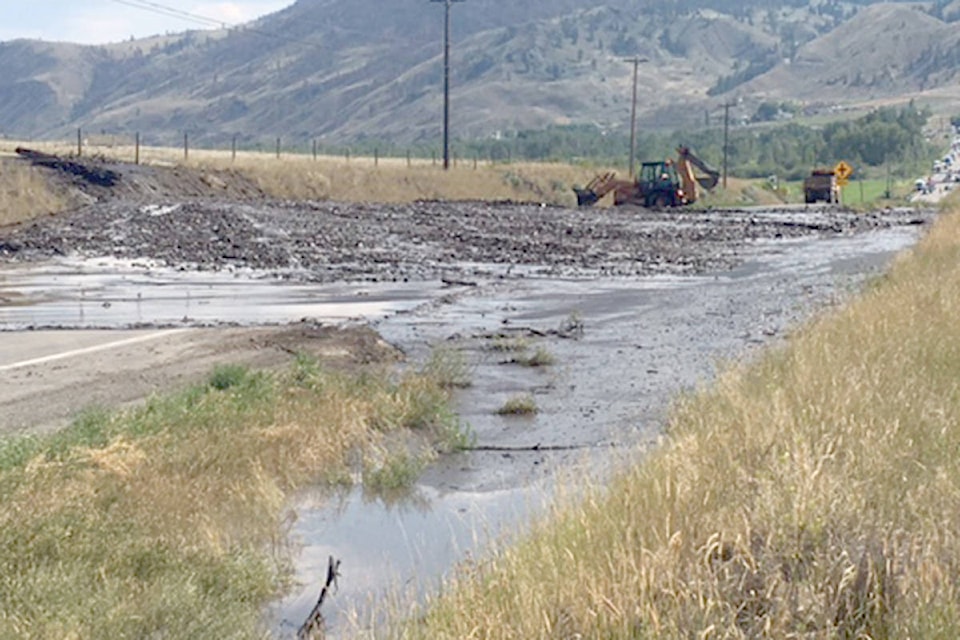This week saw mudslides between Cache Creek and Clinton. As a result, Highway 97 temporarily closed down to all traffic.
Last Tuesday’s mudslide happened just north of the intersection of Highway 97 and Loon Lake Road. The area has a very small watershed, meaning there’s no real possibility for the cause to be anything but a high concentration of rainfall, according to Dwayne Tannant, a UBC Okanagan School of Engineering professor.
“With a large convective storm cell, it is common to see small mudflows concentrated in the same area where the storm cell passes. This occurred a few years [ago] along Highway 99. Another well-documented example occurred at Stemwinder park a decade or so ago.”
After the Stemwinder mudflow in 2004, experts from the Ministry of Forests as well as two consultants wrote a paper titled The Stemwinder Creek Mud Flow, an unusual event?
They concluded that “the reoccurrence of a similar magnitude event in Stemwinder Creek is dependent on the likelihood of a similarly sized rainfall event. If global warming models that predict more extreme weather patterns are accurate, this must be considered in future landslide risk analysis.”
Tannant echoes that sentiment.
RELATED: Ranchers stood on their porch as mudslide surrounded them
With climate change, if there’s an increase in weather extremes, we can expect to be dealing with bigger, more intense convective storm cells and hence more mudflows, he says.
“With the recent rains, the ground will be more saturated and then if another storm cell comes along, the probability of triggering a mud or debris flow will be higher.”
That’s part of the reason it’s important to keep the area clear, says Tannant.
“When the B.C. Highways guys close a section of road after an event they are also controlling the exposure of people to another similar mudflow event recognizing that the probability for another one nearby is higher given that one has already occurred. So they are controlling risk in this manner – waiting for things to dry out a little. What you do not want to happen, is to have a large number of vehicles parked and waiting near a mudslide or rockfall in a hazard-prone area, because the risk for these folks ramps way up. This has happened in B.C. before and people have lost their lives waiting in an area with elevated rockfall and avalanche hazard.”
It is difficult to reduce the risk of an event such as a mudslide with mother nature controlling the weather, the forest fires, the geology, the steepness of the terrain and more, he says.
“We might be able to control or direct the path of a mudslide with things like deflection berms or ditches. We might be able to control the exposure to the hazard by placing infrastructure away from potential impact zones. And, we might be able to control the exposure of people to hazards by informing them of risky times to be on the road, etc.,” says Tannant. “Minimizing risk usually comes with a financial cost too. So there is always this tension between spending money and what risk is acceptable to society.”
For linear infrastructure, such as roads, power lines or pipelines, as well as other infrastructure, there may be few alternatives to exposing the infrastructure to the hazards.
RELATED: B.C. woman launched from pool by force of mudslide
The effect of fire on soil
Wildfires create water-repellent layers, University of Idaho Forestry Associate Extension Specialist Yvonne Barkley notes in After the Burn, Assessing and Managing Your Forest Land after a Wildfire.
“Water repellency is most often seen after moderate to severe fires, and often is more severe on dry, sandy soils and least severe on wet, fine textured soils. Generally, water repellency weakens with each rainfall and does not persist for longer than two to four years after a burn.”
“Fire further alters physical soil properties by destroying organic matter, which is essential for maintaining soil structure. The removal of organic matter can increase soil bulk density and decrease porosity, resulting in decreased infiltration and storage as well as increased runoff and erosion.”
Like us on Facebook and follow us on Twitter.
